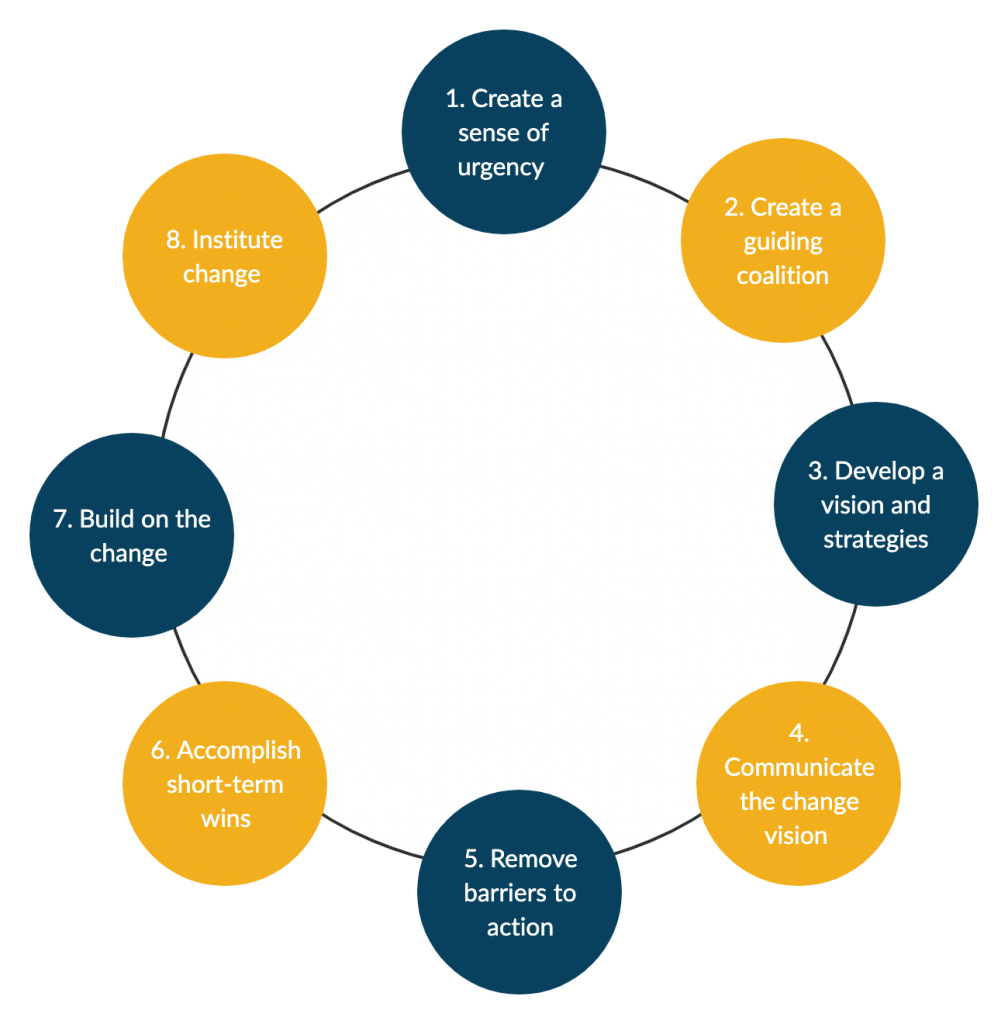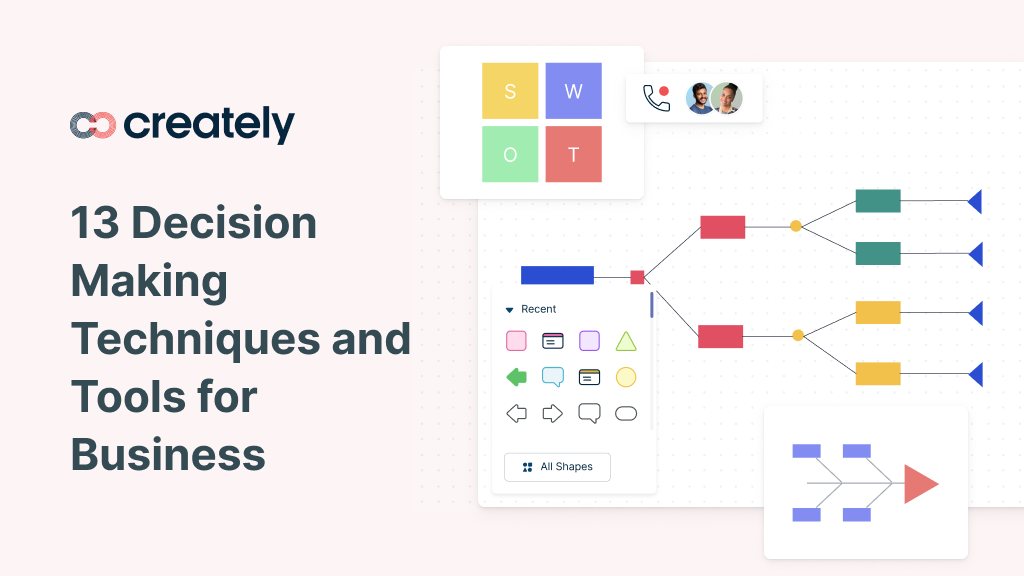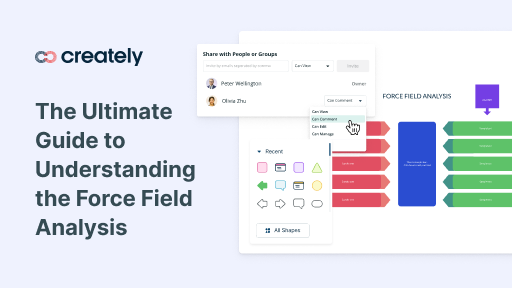Change is difficult. Especially in the context of an organization, change could interrupt the status quo and lead to conflict. But change is needed. And to successfully implement change, you need to rely on a proper framework.
This is where Kotter’s 8 step change model comes into play. It outlines how to systematically and effectively implement change in an organization.
This post explains the Kotter’s 8 step change model in detail, simplifying the process of applying it to your organization.
What is Kotter’s 8 Step Change Model
John Kotter’s 8 step change model is a popular framework for successfully implementing organizational change, and is used across many industries. It was introduced in his book “Leading Change” which was based on years of research that revealed there’s only a 30% chance of successful implementation of organizational change.
Change can come as new technologies, mergers, and acquisitions, new strategies, cultural transformation, etc.

A Bit about Kotter
John P. Kotter, professor at Harvard Business School, is known worldwide as the authority on leadership and change.
His best-selling book “Leading Change” which discusses mistakes organizations often make when implementing change and an eight-step process for successfully bringing about change, is widely referred to by managers as the bible of change across the world.
What are the 8 Steps in Kotter’s Change Model
Implementing change isn’t always easy. Barriers can come in various forms; lack of teamwork or leadership, rigid workplace cultures, arrogant attitudes, general human fear, etc. can disrupt any change implementation project.
Kotter highlights 8 steps organizations should follow to overcome such challenges and put large-scale change into effect successfully. Following these steps will ensure that at the end of the process, the organization will not only be prepared but also be committed to embracing the changes.
1. Creating a Sense of Urgency
The process should start with establishing a sense of urgency among both managers and employees. Everyone involved should feel the need for change or that change is critical for organizational growth. Without their support, it will make it difficult to keep the momentum of the change initiative and achieve lasting transformation.
The objective of this step should be to prepare the employees for the upcoming change and motivate them to offer their contribution.
For this step to succeed, roughly 75% of the organization’s management should support the change initiative. In order to create an environment where everyone is aware of the existing problem
- Identify existing threats and opportunities affecting the organization. Here you can use a SWOT analysis with the team. Based on it you can then develop future scenarios portraying what could happen

- Openly discuss with employees about what is happening and why change is necessary at this time
- Create a forum to talk about the issues, threats and the possible solutions
- Ask support from stakeholders and industry experts to back you up on your stance
2. Putting Together a Guiding Coalition
This step is dedicated to bringing together a competent team with the right skills, qualifications, reputation, connections and sufficient power to provide leadership to the change efforts and influence stakeholders.
The size of the team will vary depending on the nature of the proposed change. However, an effective team should include the following supporters,
- The sponsor: this is usually a senior executive who will be responsible for the change initiative. His/ her responsibilities include providing executive-level support and the needed resources to carry out the change initiative.
- The senior guiding team: the members here are selected by the sponsor. It consists of individuals (leaders) with sufficient authority in the area to make decisions and gather the relevant resources and support for the project. The team will be responsible for developing the vision and strategies, providing the resources, removing obstacles, guiding the organization during the process, resolving conflicts and communicating with the stakeholders.
- Filed guiding team: this includes highly credible and respected people who represent the constituencies in the organization that have a stake in the change. Their role is to communicate the vision and guide the organization through the process.
- Change teams: these are the groups of managers and supervisors whose responsibility is to make sure that the tasks are successfully completed on time. They’ll also play a part in the design and the deployment of the change program.
Once a team is assembled, focus on setting clear goals and developing an environment of trust and commitment. An effective team should
- Have a shared understanding of the need for change
- Have a common understanding of the mission and purpose of the team, as well as the goals and objectives it’s trying to achieve
- Have a clear idea about the roles and responsibilities of each other as well as the performance measures
- Understand the risks and challenges associated with the change initiative and the success factors
- Have clear processes for measuring success, decision-making, tracking issues, and resolving conflicts
- Have clear communications channels
3. Developing Vision and Strategies
The objective of this step is to create a sensible vision to direct the initiative and to develop effective strategies to help the team achieve it. It helps create a picture of what the future of the organization looks like once the change is implemented.
The right vision help achieve change successfully by inspiring and guiding team actions and decisions. It should also define clear and realistic targets to help easily measure success and appeal to the interest of the company stakeholders.
To set a clear and appealing vision,
- Align it with values central to the organization and the change initiative
- Accept the ideas of employees when developing the vision
- Make sure that it can be communicated easily and is easy to understand by everyone
- Incorporate data such as forecasts, market research data, business trends, etc.
- Ensure that it is simple enough to be explained in five minutes or less
4. Communicating the Change Vision
In this step, the focus is on effectively communicating the vision and the strategies in ways that help encourage the rest of the organization to accept and support the change initiative.
The goal here is to capture the hearts and minds of the employees; to get them to make sacrifices to support the change, to get them to believe that change is possible and the resulting benefits are for the best of the organization as well as themselves.
To do this effectively,
- Communicate the vision and strategies as frequently as you can by incorporating it in the daily decision-making, problem-solving and actions
- Walk the talk. It’s important that the senior management demonstrate the ideal behavior that they expect from the rest of the employees
- Encourage feedback from employees and address their anxieties, problems, anger, and concerns openly and honestly
- Use simple words when communicating the message to avoid confusion and doubt
- Make use of all the organizational communication channels to get the word out. This may include platforms varying from emails and newsletters to the company intranet
5. Remove Barriers to Action
When implementing organizational-wide change, obstacles may occur frequently. Barriers may come in the form of insufficient processes, resistance to change by employees themselves, disempowering managers, organizational policies and its structure, etc.
And in this step, the guiding coalition and the senior management should focus on removing such obstacles that block the organization’s path to achieving the change vision.
- Clearly understand the barriers within the organization that are blocking the implementation of change. The guiding coalition that consists of employees with different expertise can help in this step. And openly communicating with employees and stakeholders can also help identify the barriers.
- Make sure that organizational processes, structures, policies, reward systems, etc. are aligned with the new change vision.
- Recognize and reward employees that actively work on implementing change
- Empower employees to do their best and face challenges successfully by giving them the necessary training, coaching and mentoring.
6. Accomplish Short-Term Wins
Achieving complete real transformation may take time. Going so long without any victories to celebrate may discourage employees. To keep the momentum going and to encourage employees to keep backing the initiative, it’s important to have short-term goals to accomplish and celebrate early in the change process.
A short-term win is an organizational improvement that can be implemented within a short period of time. Such a quick win should be visible throughout the organization, unambiguous, and related to the change initiative.
- Identify feasible short-term wins; for example, this could include efforts that may help cut back costs, improve processes, increase profit, etc. It’s important to thoroughly consider the pros and cons of the target you select as failing an early goal may discourage the team.
- Break down the change project into smaller parts with short-term goals
- Acknowledge and reward those who are responsible for these quick wins to encourage other employees as well
7. Build on the Change
This step is all about sustaining the implementation of change by ensuring that the teams are working persistently towards achieving the change vision while measuring progress. It’s important to make sure that the team doesn’t declare victory prematurely after a few quick wins.
To continue the momentum of change,
- After every win, identify what worked and what went wrong to decide what needs to be improved
- Consolidate the gains from the quick wins and continue to work on implementing larger change throughout the organization
- Identify and remove unnecessary processes and inter-dependencies
- Continue communicating the vision and delivering benefits
8. Make Change Stick
In this step, the change leaders work on nurturing a new culture where change can stick. This includes changing organizational norms and values, processes, reward systems, and other infrastructure elements to make sure that everything aligns with the new direction.
To successfully implement change,
- Discuss the importance of the new changes by pointing out the benefits they bring
- Identify and incorporate norms and values that reinforce the change
- Incorporate these new norms and values when selecting and hiring new talent, promoting employees, etc.
- Create new training and development programs to help employees develop skills and competencies relevant to the new changes
- Improve or eliminate organizational processes that do not align with the new culture. Also, remove individuals who are hindering progress.
The Ultimate List of Change Management Tools to Drive Change Like a Pro
Ready to Implement Change?
Implementing organizational-wide change is not quick or easy. It requires patience, preparation, and persistence. A good framework to help you keep yourself on track during this long journey is Kotter’s 8 step change model. By following these 8 steps, you can ensure the successful implementation of change within your organization.
Got anything to add? Let us know in the comments section below.





